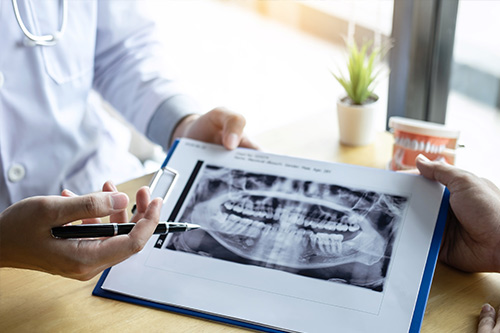First orthodontic visit
The orthodontist will use a small hand-held mirror to gently pull your child’s cheek away the teeth for better viewing, and to look at the backs of upper teeth. Your child will be asked to bite down so the orthodontist can observe how the top and bottom teeth come together, and evaluate the positions of the upper and lower jaws. A staff member may take notes about what the orthodontist finds.
This visit is the time for the orthodontist to listen to concerns that the parent and the child may have, and to answer questions such as whether treatment is needed, when treatment should begin, and the type of treatment that is recommended. If no problem is found, the orthodontist may suggest periodic visits so that your child’s growth and development can be monitored, and ensure that permanent teeth are coming in at the right time and in the right sequence.

When should my child have the first visit with an orthodontist?
The American Association of Orthodontists recommends that children have their first check-up with an orthodontist no later than age 7. By that age, a child will have a mix of baby and permanent teeth, and the orthodontist will be able to recognize orthodontic problems (“malocclusions”) even in their earliest stages.
If your child is younger than 7, and you notice something that appears “off,” it’s not necessary to wait until your child turns 7 or get a recommendation from your dentist to get a first check-up. If your child is 8 or older, it is not too late for a check-up with an orthodontist.
Will anything be uncomfortable for my child at a first visit?
No. Your child should experience no discomfort during the visit.
What will I learn from the first visit?
Five essential questions are generally covered during the first exam:
- Is there an orthodontic problem, and if so, what is it?
- What are the options to correct the problem?
- Is there a possibility teeth will need to be removed?
- About how long is the recommended treatment expected to take?
- How much will the recommended treatment cost?
Am I allowed to be present for the exam?
Yes.
What happens if an orthodontic problem is found during this visit?
The orthodontist will talk to you about when it will be most advantageous for your child to begin treatment, and the type of treatment that is recommended. For some children, early intervention (while some baby teeth are present) may be in their best interests. Different people have different kinds of problems, so other children may get the greatest benefit from treatment by waiting until most or all of the permanent teeth are in. Everything depends upon the individual and what is best for them.
If the orthodontist recommends a “wait and see” approach, your child’s growth and development will be assessed periodically, and treatment can be timed to take advantage of predictable stages of growth. For some patients, the orthodontist will be able to achieve treatment results that may not be possible once the face and jaws have finished growing.
What if my child has special needs?
When you make the appointment for the first visit, be sure to inform the person who makes your appointment if your child has special needs, and explain what the needs are. This way, the doctor and staff can prepare for your child’s visit and make it as pleasant and comfortable for him/her as possible. If your child’s special needs are such that the doctor is unable to accommodate your child, you will be informed when making the appointment. The orthodontist may be able to provide a suggestion on a colleague who would be able to accommodate your child’s special need.
Will the orthodontist take x-rays?
A special x-ray called a “panoramic” x-ray, may be taken at a first exam, or may be postponed until closer to the time that it’s recommended treatment begins.
Are x-rays really necessary?
Yes. In order for the orthodontist to be able to accurately diagnose your child’s orthodontic problem, x-rays are necessary. They reveal what could otherwise only be guessed.
Today’s x-ray machines require significantly less radiation to obtain an image, as compared to x-ray machines of a generation ago.
An accurate diagnosis allows your orthodontist to plan every step of your child’s treatment so that your child finishes treatment with a healthy bite – referring to the way upper and lower teeth meet and work together. Teeth in a healthy bite are also straight, making for a beautiful smile.
Is there anything else I should expect at a first visit?
Yes. The orthodontist or a staff member may take photographs of your child’s teeth and face. This can be valuable documentation referred to at subsequent visits.
Will the orthodontist tell our dentist about this visit?
Yes. The orthodontist will communicate the results of this visit with your child’s dentist, including recommended next steps, if any. However, if you prefer that the dentist not be informed, the orthodontist will comply with your wishes.
